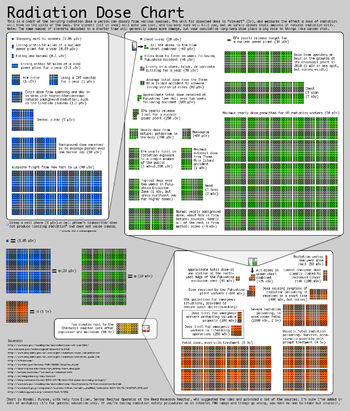Radiation Hazards: Difference between revisions
Jess Brewer (talk | contribs) No edit summary |
Jess Brewer (talk | contribs) No edit summary |
||
| Line 2: | Line 2: | ||
{{seealso|Nuclear_power_reconsidered}} | {{seealso|Nuclear_power_reconsidered}} | ||
{{Image|XKCD Radiation Chart.png|right|350px|Fig. 1 Handy chart from [http://xkcd.com/radiation xkcd.com] compares radiation doses.}} | {{Image|XKCD Radiation Chart.png|right|350px|Fig. 1 Handy chart from [http://xkcd.com/radiation xkcd.com] compares radiation doses.}} | ||
{{Image|Electrify5Radiophobia.009.jpeg|right|350px|Fig. 2 Effects of | {{Image|Electrify5Radiophobia.009.jpeg|right|350px|Fig. 2 Effects of free radicals on DNA.}} | ||
One of the primary obstacles to nuclear power is the public's fear of ''radiation''. While ionizing radiation can certainly be dangerous at high doses, because most people have difficulty distinguishing between a ''little'' and a '''lot''', this has often been oversimplified to, "The only acceptable amount of radiation is ''zero''!" That goal can never be met, since (for example) all living things are radioactive. A sensible criterion must be based on an understanding of where radiation comes from, what sorts of damage radiation ''does'', and how much radiation it takes to ''do'' it.<ref>[https://jick.net/skept/RadHaz/RadHaz_talk.pdf Lecture on Radiation Hazards] Jess H. Brewer</ref> | One of the primary obstacles to nuclear power is the public's fear of ''radiation''. While ionizing radiation can certainly be dangerous at high doses, because most people have difficulty distinguishing between a ''little'' and a '''lot''', this has often been oversimplified to, "The only acceptable amount of radiation is ''zero''!" That goal can never be met, since (for example) all living things are radioactive. A sensible criterion must be based on an understanding of where radiation comes from, what sorts of damage radiation ''does'', and how much radiation it takes to ''do'' it.<ref>[https://jick.net/skept/RadHaz/RadHaz_talk.pdf Lecture on Radiation Hazards] Jess H. Brewer</ref> | ||
Figure 1 compares a range of radiation exposures, from the dose received from sleeping next to another human (0.05 <math>\mu</math>Sv) to the usually fatal dose of 4 Sv, a hundred million times greater. ''Warning'': such comparisons can be misleading unless one understands that some are "delivered all at once" and others are "accumulative" over times up to a year. There is great controversy over the latter, since DNA usually "heals" strand-breaks due to ionizing radiation (see Fig. 2) within hours or days,<ref>[https://www.ncbi.nlm.nih.gov/pmc/articles/PMC4060780/ "Effects of Ionizing Radiation on Biological Molecules—Mechanisms of Damage and Emerging Methods of Detection", Julie A. Reisz, Nidhi Bansal, Jiang Qian, Weiling Zhao, and Cristina M. Furdui] doi: 10.1089/ars.2013.5489</ref> suggesting that doses may not "accumulate" over longer periods. | Figure 1 compares a range of radiation exposures, from the dose received from sleeping next to another human (0.05 <math>\mu</math>Sv) to the usually fatal dose of 4 Sv, a hundred million times greater. ''Warning'': such comparisons can be misleading unless one understands that some are "delivered all at once" and others are "accumulative" over times up to a year. There is great controversy over the latter, since DNA usually "heals" strand-breaks due to free radicals produced by ionizing radiation (see Fig. 2) within hours or days,<ref>[https://www.ncbi.nlm.nih.gov/pmc/articles/PMC4060780/ "Effects of Ionizing Radiation on Biological Molecules—Mechanisms of Damage and Emerging Methods of Detection", Julie A. Reisz, Nidhi Bansal, Jiang Qian, Weiling Zhao, and Cristina M. Furdui] doi: 10.1089/ars.2013.5489</ref> suggesting that doses may not "accumulate" over longer periods. | ||
==Notes and References== | ==Notes and References== | ||
Revision as of 10:39, 27 March 2022
- See also: Nuclear_power_reconsidered

One of the primary obstacles to nuclear power is the public's fear of radiation. While ionizing radiation can certainly be dangerous at high doses, because most people have difficulty distinguishing between a little and a lot, this has often been oversimplified to, "The only acceptable amount of radiation is zero!" That goal can never be met, since (for example) all living things are radioactive. A sensible criterion must be based on an understanding of where radiation comes from, what sorts of damage radiation does, and how much radiation it takes to do it.[1]
Figure 1 compares a range of radiation exposures, from the dose received from sleeping next to another human (0.05 Sv) to the usually fatal dose of 4 Sv, a hundred million times greater. Warning: such comparisons can be misleading unless one understands that some are "delivered all at once" and others are "accumulative" over times up to a year. There is great controversy over the latter, since DNA usually "heals" strand-breaks due to free radicals produced by ionizing radiation (see Fig. 2) within hours or days,[2] suggesting that doses may not "accumulate" over longer periods.

